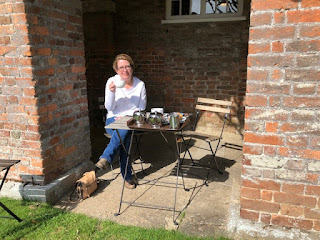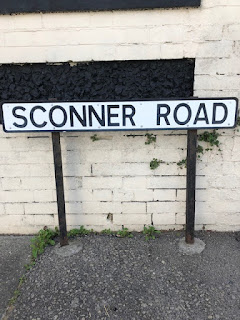I learned an important lesson at Antony. If I ever inherit a country estate (chances of this: absolutely nil) then I will definitely give it a person's name. It's so much homelier to say "we're spending the summer at Antony" rather than "will you be joining us at Boggington Hall?". When you see an episode of Grand Designs with Kevin McCloud saying "she has decided to call the house...<condescending face> Rodney", you'll know it's me.
Antony is in Cornwall, so it's a bit ironic that it was the first stop on my National Trust Scone Tour of Devon (Part Two). We picked up a hire car in Plymouth and set off for the Torpoint Ferry to take us across the Tamar. My experience of ferries (Fishguard to Rosslare and Southampton to Cowes) had me prepared for hours of faff/fumes/vomit but it was over in a matter of minutes. No passport control, no need to sign any forms declaring that I wasn't bringing a bootload of Langage Farm clotted cream over the border, nothing.
Here are some highlights of Antony:
It has been home to the Carews since the early 1400s
Sir Nicholas Carew married Joan Courtenay in the 15th century and settled at Antony, which she had inherited. They had four sons who created Carew dynasties in several properties across Cornwall. In 1772 the estate went to Reginald Pole, who was the great-great grandson of the 3rd Baronet. He changed his surname to Pole-Carew. His descendants changed it again later on to Carew-Pole and they still live at Antony today.
The Carews got executed for treason a lot
Sir Alexander Carew, the 2nd Baronet, declared for Parliament during the Civil War but changed his mind when things looked a bit iffy and offered to surrender Plymouth to the Royalists if he was pardoned. The Parliamentarians found out about his plan and he was beheaded in 1644. His half-brother, John, was one of the 59 regicides that signed Charles I's death warrant. He was hunted down by Charles II in 1660 and hanged, drawn, and quartered. Samuel Pepys wrote of him; "but his quarters, by a great favour, are not to be hanged up". I'm sure he'd have preferred the greater favour of not being chopped into pieces at all. This didn't stop William Carew, the builder of the house we see at Antony today, from taking the risk of supporting the Jacobite cause - he did time for it but survived.
They had a range of interests
Richard Carew, who died in 1620, was an avid reader. He wrote The Survey of Cornwall and various other works including a poem about how much he loved his 'fishful pond'. His son, also Richard, was "the best bee-keeper in Cornwall".
The present house was built in 1720
William Carew, the 5th baronet, built Antony as we see it today. He had made a very advantageous marriage which helped him to finance it, although it all got a bit worrying when his father-in-law decided to remarry late in life and a male heir was a very real possibility. Luckily for William, and for Antony, it didn't materialise.
Reginald Pole-Carew inaugurated the Torpoint Ferry!
If only I had known this as we set sail on our 5 minute voyage; Reginald Pole-Carew introduced the Torpoint Ferry in 1790.
Lady Beatrice Pole-Carew created a tree tent to watch the tennis
I loved the conical yew tree in the garden but it seems that Lady Beatrice didn't - she only sat it in once to watch the family playing tennis on the courts opposite but she was pestered by insects and didn't use it again.
The tea room is wonderful
The cafe at Antony goes straight into my top ten of National Trust Tea Rooms, purely because you can sit facing the house pretending that you live there. My sister was with me for this trip and she allowed herself to make like Lady Beatrice and be pestered by insects (in this case her greatest phobia: wasps) so we could take full advantage:
The Antony scone was quite surprising because it wasn't sweet. The jam did all the heavy lifting on that front and that's fine by me - you get it a lot in Devon. It had been baked to perfection though, and it was a very good size, so it gets top marks.
Torpoint also had one other treat in store for me: as we drove through, I spotted the road sign below and insisted on going back for a photo opportunity.
I was tempted to ask my sister to video me swinging round a lamp post singing "The Street Where I Intend To Live" from My Fair Lady (sort of), but I settled for having my photo taken next to the sign. I posted it on Instagram later and someone replied "Are you in Torpoint?", which always makes a trip worthwhile (although nothing will ever beat the NT employee who correctly identified a completely non-descript piece of car park.)
Antony: 5 out of 5
Scone: 5 out of 5
Opportunity to swing round lamp post singing 'All at once am I, several storeys high! Knowing I'm on the street where I intend to live!' 5 out of 5
Antony is in Cornwall, so it's a bit ironic that it was the first stop on my National Trust Scone Tour of Devon (Part Two). We picked up a hire car in Plymouth and set off for the Torpoint Ferry to take us across the Tamar. My experience of ferries (Fishguard to Rosslare and Southampton to Cowes) had me prepared for hours of faff/fumes/vomit but it was over in a matter of minutes. No passport control, no need to sign any forms declaring that I wasn't bringing a bootload of Langage Farm clotted cream over the border, nothing.
Here are some highlights of Antony:
It has been home to the Carews since the early 1400s
Sir Nicholas Carew married Joan Courtenay in the 15th century and settled at Antony, which she had inherited. They had four sons who created Carew dynasties in several properties across Cornwall. In 1772 the estate went to Reginald Pole, who was the great-great grandson of the 3rd Baronet. He changed his surname to Pole-Carew. His descendants changed it again later on to Carew-Pole and they still live at Antony today.
The Carews got executed for treason a lot
Sir Alexander Carew, the 2nd Baronet, declared for Parliament during the Civil War but changed his mind when things looked a bit iffy and offered to surrender Plymouth to the Royalists if he was pardoned. The Parliamentarians found out about his plan and he was beheaded in 1644. His half-brother, John, was one of the 59 regicides that signed Charles I's death warrant. He was hunted down by Charles II in 1660 and hanged, drawn, and quartered. Samuel Pepys wrote of him; "but his quarters, by a great favour, are not to be hanged up". I'm sure he'd have preferred the greater favour of not being chopped into pieces at all. This didn't stop William Carew, the builder of the house we see at Antony today, from taking the risk of supporting the Jacobite cause - he did time for it but survived.
They had a range of interests
Richard Carew, who died in 1620, was an avid reader. He wrote The Survey of Cornwall and various other works including a poem about how much he loved his 'fishful pond'. His son, also Richard, was "the best bee-keeper in Cornwall".
The present house was built in 1720
William Carew, the 5th baronet, built Antony as we see it today. He had made a very advantageous marriage which helped him to finance it, although it all got a bit worrying when his father-in-law decided to remarry late in life and a male heir was a very real possibility. Luckily for William, and for Antony, it didn't materialise.
Reginald Pole-Carew inaugurated the Torpoint Ferry!
If only I had known this as we set sail on our 5 minute voyage; Reginald Pole-Carew introduced the Torpoint Ferry in 1790.
Lady Beatrice Pole-Carew created a tree tent to watch the tennis
I loved the conical yew tree in the garden but it seems that Lady Beatrice didn't - she only sat it in once to watch the family playing tennis on the courts opposite but she was pestered by insects and didn't use it again.
The tea room is wonderful
The cafe at Antony goes straight into my top ten of National Trust Tea Rooms, purely because you can sit facing the house pretending that you live there. My sister was with me for this trip and she allowed herself to make like Lady Beatrice and be pestered by insects (in this case her greatest phobia: wasps) so we could take full advantage:
 |
| If I had taken this from the other direction, you'd have been able to appreciate its location facing the house. But I didn't so you'll have to imagine it. |
Torpoint also had one other treat in store for me: as we drove through, I spotted the road sign below and insisted on going back for a photo opportunity.
I was tempted to ask my sister to video me swinging round a lamp post singing "The Street Where I Intend To Live" from My Fair Lady (sort of), but I settled for having my photo taken next to the sign. I posted it on Instagram later and someone replied "Are you in Torpoint?", which always makes a trip worthwhile (although nothing will ever beat the NT employee who correctly identified a completely non-descript piece of car park.)
Antony: 5 out of 5
Scone: 5 out of 5
Opportunity to swing round lamp post singing 'All at once am I, several storeys high! Knowing I'm on the street where I intend to live!' 5 out of 5





No comments:
Post a Comment